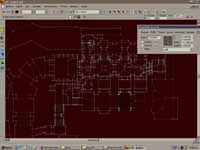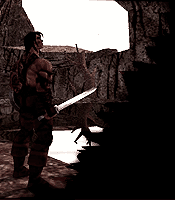|
Level Designer: Fernando Del Ama
I started to work at Rebel Act in 1996. I had
just finished my courses in the Architecture School in Madrid in
those days. Then I heard about "Blade". I had no experience
with video games, but it wasn't any problem because we wanted to
create something new; nothing like any videogame made before.
 This
is a picture from the Levels Editor (Led). It's the plan of the
Ice Fortress, one of the last levels in the game. The ice fortress
is probably my favorite, because this was the first one I finished.
I have totally designed six levels and the tutorial. This
is a picture from the Levels Editor (Led). It's the plan of the
Ice Fortress, one of the last levels in the game. The ice fortress
is probably my favorite, because this was the first one I finished.
I have totally designed six levels and the tutorial.
Actually we (the level designers) are now finishing
every single detail, like textures, enemies, objects, lights etc.
When this picture was taken I was trying to reduce the polygons
on the screen in order to increase the frames per second and make
it more enjoyable.
I could say lots of things about the Led. At
first it was difficult to work with it because it's different to
any other editors. It has its own rules and only when you know these
rules you can start making good levels. For example, rooms are created
by digging in a solid world, which makes it hard creating columns
or stanchions but better for making exteriors and open spaces. We
can place any object modeled in Max into the level, and dynamic
lights are linked to those objects. If these objects have the same
textures as the level it will be difficult to see the differences,
because the lights and shadows affect in the same way to walls,
objects and characters. Adding special characteristics to a level,
as water, is different. We must add the water to the levels by writing
a few script lines.
The first step is to think out the general
style of the level. We have many locations and we tried to make
them as real as we could by choosing good textures and an appropriate
architectural style. The Led is the tool we use to create the room
and adjust the textures to any wall. But the room is not finished
without lights and objects. Then I place the enemies checking if
it's necessary to place items (life potions, weapons, shields...)
to make it easier. At last I place the sounds by using ghost sectors
with the Led, but sounds can also be placed by script.
Texturing the levels is the most time-consuming
part. To make a good texture for the game takes days of hard work,
and even if the texture is good it must be adjusted in brightness,
contrast and colors... for every different level. After years of
hard work, all the levels have the same quality.
There are many things to take into account
when designing a level. It's not only a question of the level, but
also of where it is placed in the context of the game. The only
limit, in how large a level can be, is our imagination and how it
will affect the gameplay. We're trying to make them in a way so
that most people will be able to finish a normal level in two or
three hours, excluding the secret areas, but they could be as long
as we want. You also have to know that the compiling time increases
a lot if the level has more than 3000 different rooms, but it really
depends on the computer.
Most of the time we have been working on one
Monitor. Now we are using two, but this is not strictly necessary.
With the led, which will be made available, you can make both single
player levels and multiplayer levels. You will also be able to to
add 3rd party objects modeled in max, textures and etc into your
designs.
Previous
| Index | Next
|





